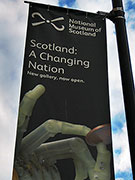 Click here to see Rupert’s photos of Edinburgh
Click here to see Rupert’s photos of Edinburgh
When I went to Edinburgh recently I expected to see high street shops selling off their stocks at huge discounts and “everything must go” signs. But I was surprised to find that it looked like “business as usual” and I didn’t see any boarded up windows, stray dogs, rubbish blowing down the streets or any other signs that capitalism had failed. My plan of getting a cheap jacket from a collapsing retail giant were foiled.
What I did find was a spectacular light show in the sky. The quality of light in Scotland, especially in the winter, is quite different from anything I have seen in continental Europe.
Although I spent my childhood and youth in Scotland I never appreciated its light, or the unpredictable nature of the weather. I just hated the fact that it was usually cold, windy and wet (often all three) and I was a firm believer in Dr Johnson’s aphorism, “The noblest prospect which a Scotchman ever sees is the high road that leads him to England.”
There is constant movement as the wind pushes clouds around with unseemly haste. The clouds come in every shape and size imaginable — from puffy balls of cotton wool to dark brooding banks of rain that hover threateningly over the horizon — and the sun, which remains hidden from view for most of the winter, lights up these clouds in a series of brief flashes and momentary sunbursts.
Edinburgh is a paradox. It never changes and yet it is always changing: its architecture has remained unchanged for centuries (but new buildings are constantly creeping in); it is known as The Athens of the North as well as a hotbed of heroin addiction (as portrayed in Trainspotting); and its New Town was built over 200 years ago. I’ve always considered Edinburgh to be a good place to visit, but not such a great place to live as there aren’t enough people (just 448,000 according to Wikipedia) to enable it to escape from its provincial status.
Perhaps one has to be an artist to really appreciate Scotland, or a hillwalker equipped with the latest goretex and cheerily oblivious to spitting clouds and howling gales. At one point I was under fire from a sudden hailstorm, driven by a fierce wind, and at the same time the sun was shining directly on me. I felt like the weather was mocking, playful, teasing.
Edinburgh used to have a ancient hospital complex right in the middle of town. It was called the Royal Infirmary and my daughter Lara was born there in 1999. It was a sprawling Victorian institution with turrets, gothic architecture and a floor plan that confused everyone. It would have been a suitable location for Hogwart’s in the Harry Potter films (which would have been interesting considering that JK Rowling lives just round the corner).
My brother Gavin walked me past the “new” Royal Infirmary and I must admit to being impressed by the changes, as long as I didn’t think about the fact that the hospital has been moved to a field outside of town. The Victorian buildings are being renovated into posh flats and offices and a well designed new construction of wood and glass has replaced the ugly emergency room that had blighted the place since the 1960s.
Ever since Scotland got a watered-down version of independence from England there have been a series of major financial scandals. The most famous of these is the construction of an ugly Parliament building which went over budget by ten times, to 400 million pounds sterling.
The current scandal in Edinburgh is the new tram line from the airport. This is a project which nobody seems to want, is likely to cost a billion pounds sterling, has resulted in the centre of Edinburgh being dug up, and will terminate in a field near the airport (but not at the airport).
What I find interesting about this project is that tram lines are such an expensive and complicated investment in Britain, whereas in Romania the renovation of tramlines is a routine job that get done with a lot more speed and efficiency than happens in Scotland (at a far less cost).
In Romania the tram is the lowest class of transport; in Scotland I am sure it will be a high class affair. This contrasts with golf, a game that was invented in Scotland and is still a working class game where municipal golf courses are common and entry fees still low. In much of the world, golf courses are massive private investments that only the super rich can afford.
A friend of mine who came to Edinburgh asked his taxi driver what role does Scotland’s new Parliament have? What responsibility do they have? The taxi driver answered wryly “our Parliament has authority over all the issues that don’t matter”.
Reading your latest blog entry, I do understand how to put an idea you couldn’t say in more than few lines in a long article. I do have a problem with this. You take the idea and put it in the context, and the context brings many new ideas to fill in the space. You told me you wanna write an article about light is Edinburgh but it’s so much more than that there.